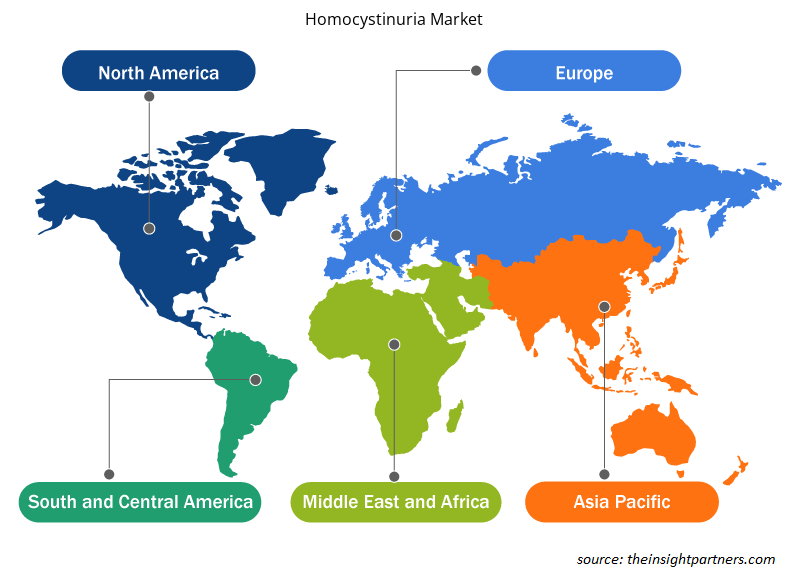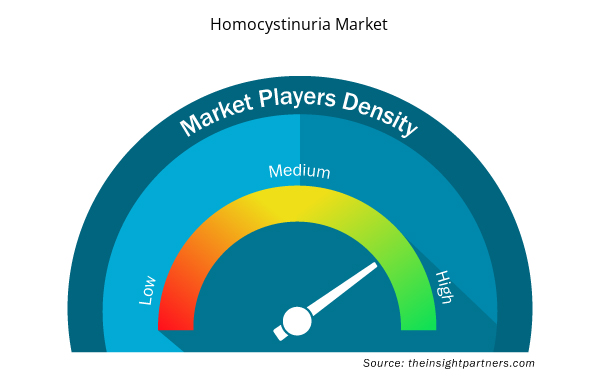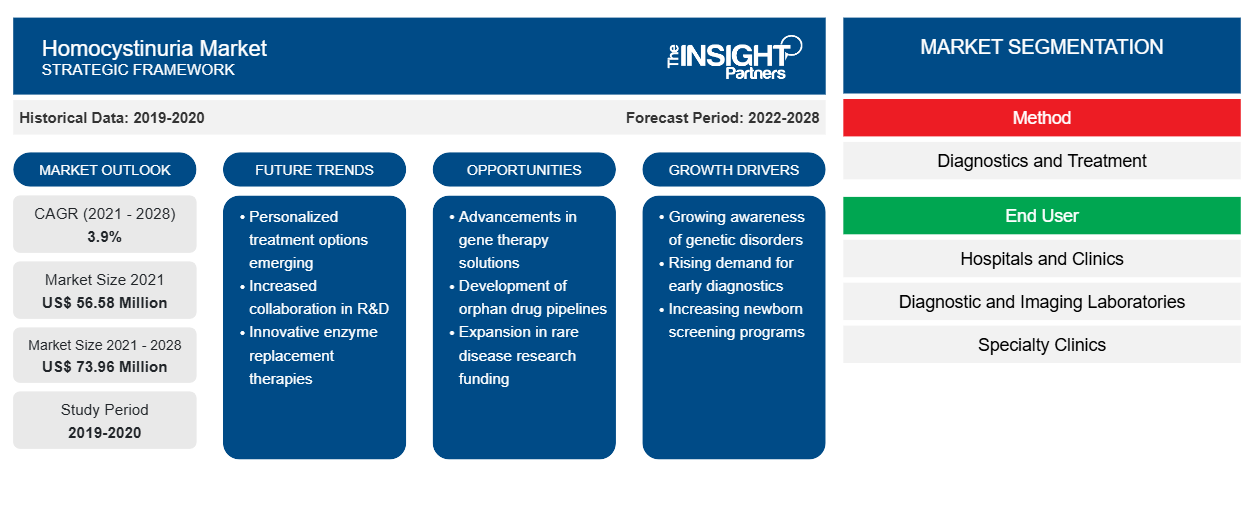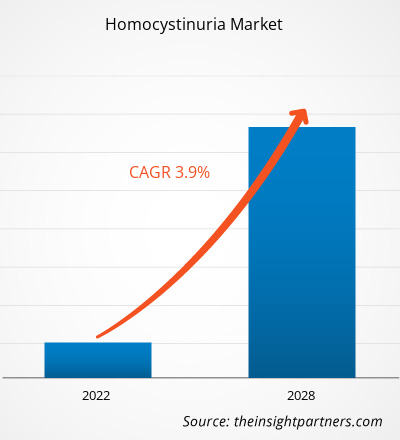Se proyecta que el mercado de homocistinuria alcance los 73,96 millones de dólares en 2028, desde los 56,58 millones de dólares en 2021; se estima que crecerá a una CAGR del 3,9 % durante 2021-2028.
La homocistinuria es una enfermedad genética en la que el cuerpo no puede digerir correctamente ciertos componentes básicos de las proteínas (aminoácidos). La homocistinuria se presenta en distintos tipos, cada uno con su propio conjunto de signos y síntomas, así como una etiología hereditaria. La miopía, la dislocación del cristalino en la parte frontal del ojo, un mayor riesgo de coagulación sanguínea irregular y huesos frágiles propensos a fracturarse (osteoporosis) u otras anomalías esqueléticas definen la forma más frecuente de homocistinuria. Algunas de las personas afectadas también presentan retrasos en el desarrollo y dificultades de aprendizaje.
Personalice este informe según sus necesidades
Obtendrá personalización en cualquier informe, sin cargo, incluidas partes de este informe o análisis a nivel de país, paquete de datos de Excel, así como también grandes ofertas y descuentos para empresas emergentes y universidades.
- Obtenga las principales tendencias clave del mercado de este informe.Esta muestra GRATUITA incluirá análisis de datos, desde tendencias del mercado hasta estimaciones y pronósticos.
El crecimiento del mercado de la homocistinuria se atribuye a las crecientes deficiencias de vitamina B6 y vitamina B12 y a la creciente prevalencia de trastornos metabólicos hereditarios. Sin embargo, la falta de concienciación sobre diversos trastornos raros y trastornos metabólicos hereditarios obstaculiza el crecimiento del mercado.
Perspectivas del mercado
Las crecientes deficiencias de vitamina B6 y vitamina B12 impulsan el mercado de la homocistinuria
El aumento de los patrones de deficiencia de vitamina B6 y vitamina B12 conduce a varios trastornos como anemia, anemia megaloblástica, anemia microcítica y algún tipo de trastornos metabólicos, lo que se espera que impulse el crecimiento del mercado durante el período de pronóstico. Como se cree que la terapia con vitamina B6 es una terapia eficaz contra la homocistinuria, la deficiencia de esta vitamina puede empeorar la afección. La piridoxina (vitamina B6) actúa como un cofactor de la beta-sintasa y actúa como chaperona para estabilizar varias mutaciones sin sentido. Algunos de los pacientes con homocistinuria responden bien a la terapia con piridoxina, y ayuda a reducir los niveles de homocisteína, proporcionando así alivio de la afección. Por lo tanto, la vitamina B6 se considera vital para controlar la homocistinuria, ya que hay un número limitado de tratamientos disponibles para curar la afección. La deficiencia de esta enzima conduce a anemia y anemia microcítica. Se espera que la creciente prevalencia de la anemia estimule el crecimiento del mercado durante el período de pronóstico. Por ejemplo, según la Organización Mundial de la Salud, la anemia afecta a más de 1.620 millones de personas, es decir, el 24,8% de la población. Las principales causas de la anemia son la dieta inadecuada y las deficiencias de vitaminas como la B6, B9 y B12. Predominantemente, la deficiencia de vitamina B6 es una de las principales causas de anemia. Por lo tanto, se espera que un aumento en los casos de deficiencia de vitamina B6 y una alta prevalencia de trastornos asociados con su deficiencia respalden el crecimiento del mercado durante el período de pronóstico.
Perspectivas basadas en métodos
El mercado mundial de homocistinuria, según el método, se divide en tratamiento y diagnóstico. El segmento de tratamiento tuvo una mayor participación en el mercado en 2021. Además, se prevé que el mismo segmento registre una CAGR más alta en el mercado durante el período de pronóstico debido al uso actual del tratamiento y al aumento de la investigación y el desarrollo de nuevos tratamientos para la homocistinuria.
Perspectivas regionales del mercado de homocistinuria
Los analistas de Insight Partners explicaron en detalle las tendencias y los factores regionales que influyen en el mercado de homocistinuria durante el período de pronóstico. Esta sección también analiza los segmentos y la geografía del mercado de homocistinuria en América del Norte, Europa, Asia Pacífico, Oriente Medio y África, y América del Sur y Central.

- Obtenga los datos regionales específicos para el mercado de homocistinuria
Alcance del informe de mercado sobre homocistinuria
| Atributo del informe | Detalles |
|---|---|
| Tamaño del mercado en 2021 | US$ 56,58 millones |
| Tamaño del mercado en 2028 | US$ 73,96 millones |
| CAGR global (2021-2028) | 3,9% |
| Datos históricos | 2019-2020 |
| Período de pronóstico | 2022-2028 |
| Segmentos cubiertos | Por método
|
| Regiones y países cubiertos | América del norte
|
| Líderes del mercado y perfiles de empresas clave |
|
Densidad de actores del mercado de homocistinuria: comprensión de su impacto en la dinámica empresarial
El mercado de la homocistinuria está creciendo rápidamente, impulsado por la creciente demanda de los usuarios finales debido a factores como la evolución de las preferencias de los consumidores, los avances tecnológicos y una mayor conciencia de los beneficios del producto. A medida que aumenta la demanda, las empresas amplían sus ofertas, innovan para satisfacer las necesidades de los consumidores y aprovechan las tendencias emergentes, lo que impulsa aún más el crecimiento del mercado.
La densidad de actores del mercado se refiere a la distribución de las empresas o firmas que operan dentro de un mercado o industria en particular. Indica cuántos competidores (actores del mercado) están presentes en un espacio de mercado determinado en relación con su tamaño o valor total de mercado.
Las principales empresas que operan en el mercado de la homocistinuria son:
- BASF SE
- FARMACIA HUAZHONG
- Pfizer Inc.
- MYLAN NV
- Aeglea BioTherapeutics
Descargo de responsabilidad : Las empresas enumeradas anteriormente no están clasificadas en ningún orden particular.

- Obtenga una descripción general de los principales actores clave del mercado de homocistinuria
Información basada en el usuario final
El mercado mundial de homocistinuria, en función del usuario final, está segmentado en laboratorios de diagnóstico e imágenes, hospitales y clínicas, clínicas especializadas e institutos académicos y de investigación. En 2021, el segmento de laboratorios de diagnóstico e imágenes tuvo la mayor participación del mercado. Además, se espera que el segmento registre la CAGR más alta del 4,2% durante 2021-2028 debido al aumento del diagnóstico de trastornos metabólicos hereditarios en los laboratorios de diagnóstico e imágenes.
Los lanzamientos y aprobaciones de productos son estrategias que las empresas suelen adoptar para ampliar su presencia global y sus carteras de productos. Además, los actores del mercado de la homocistinuria se centran en la estrategia de asociación para ampliar su clientela, lo que, a su vez, les permite mantener su marca en todo el mundo.
El informe segmenta el mercado de homocistinuria de la siguiente manera
Mercado de homocistinuria: por método
- Tratamiento
- Piridoxina
- Betaína
- Otros
- Diagnóstico
- Pruebas genéticas
- Prueba de detección de aminoácidos
- Prueba de enzimas hepáticas
- Otros
Mercado de homocistinuria: por usuario final
- Hospitales y Clínicas
- Laboratorios de diagnóstico e imagen
- Clínicas de especialidades
- Institutos académicos y de investigación
Mercado de homocistinuria por geografía
- América del norte
- A NOSOTROS
- Canadá
- México
- Europa
- Reino Unido
- Alemania
- Francia
- Italia
- España
- Resto de Europa
- Asia Pacífico
- Porcelana
- Japón
- India
- Australia
- Corea del Sur
- Resto de Asia Pacífico
- Oriente Medio y África
- Emiratos Árabes Unidos
- Arabia Saudita
- Sudáfrica
- Resto de Oriente Medio y África
- América del Sur y Central
- Brasil
- Argentina
- Resto de América del Sur y Central
Perfiles de empresas
- BASF SE
- FARMACIA HUAZHONG
- Pfizer Inc.
- MYLAN NV
- Aeglea BioTherapeutics
- Amino GmbH
- Corporación KAO
- Corporación DSM
- Tecnologías huérfanas
- Fresenius Kabi AG
- Análisis histórico (2 años), año base, pronóstico (7 años) con CAGR
- Análisis PEST y FODA
- Tamaño del mercado Valor/volumen: global, regional, nacional
- Industria y panorama competitivo
- Conjunto de datos de Excel



Report Coverage
Revenue forecast, Company Analysis, Industry landscape, Growth factors, and Trends

Segment Covered
This text is related
to segments covered.

Regional Scope
North America, Europe, Asia Pacific, Middle East & Africa, South & Central America

Country Scope
This text is related
to country scope.
Preguntas frecuentes
The Asia Pacific region is expected to be the fastest-growing region among all other regions. The market in this region is expected to grow significantly in countries such as, China, Japan and India. The market is driven by increase in prevalence of inherited metabolic disorders, rise in government initiatives to manage rare diseases across the region along with increase in diagnostic tests across the region such as new born screening test etc. Therefore, the region holds huge potential for the homocystinuria market players to grow during the forecast period.
Homocystinuria is an inherited disorder in which the body is unable to process certain building blocks of proteins (amino acids) properly. There are multiple forms of homocystinuria, which are distinguished by their signs and symptoms and genetic cause. The most common form of homocystinuria is characterized by nearsightedness (myopia), dislocation of the lens at the front of the eye, an increased risk of abnormal blood clotting, and brittle bones that are prone to fracture (osteoporosis) or other skeletal abnormalities. Some affected individuals also have developmental delay and learning problems.
The growth of the Homocystinuria market is mainly attributed to factors such as the increasing prevalence of inherited metabolic disorders coupled with rise in vitamin B6 and Vitamin B12 deficiencies. However, the lack of awareness about various rare disorders and inherited metabolic disorders is hindering the market growth.
The global Homocystinuria market is expected to reach US$ 73,960.22 thousand by 2028 from US$ 56,589.20 thousand in 2021; it is estimated to grow at a CAGR of 3.9% during 2021-2028.
Emergence of human enzyme therapeutics and enzyme replacement therapy to treat rare disorders is one of the future trends of homocystinuria market. Enzyme replacement therapy and enzyme therapeutics is a type of novel drug therapy in which therapeutic enzymes are used to treat chronic and life-threatening diseases such as cancer, idiosyncratic disorders, and rare disorders. Furthermore, if an enzyme is not functioning properly in the body, then enzyme replacement therapy is used for replacing the enzyme that is deficient in the body. Enzymes have a predominant role in pharmaceutical industries and drug development as they treat various disorders. The advancements in the field of protein technology, recombinant DNA technology, enzyme immobilization, and nanotechnology have provided a solid platform for the use of enzymes in the treatment of various disorders.
Trends and growth analysis reports related to Life Sciences : READ MORE..
The List of Companies - Homocystinuria Market
- BASF SE
- HUAZHONG PHARMACEUTICAL
- Pfizer Inc.
- MYLAN N.V
- Aeglea BioTherapeutics
- Amino GMBH
- KAO Corporation
- DSM Corporation
- Orphan Technologies
- Fresenius Kabi AG.
The Insight Partners performs research in 4 major stages: Data Collection & Secondary Research, Primary Research, Data Analysis and Data Triangulation & Final Review.
- Data Collection and Secondary Research:
As a market research and consulting firm operating from a decade, we have published and advised several client across the globe. First step for any study will start with an assessment of currently available data and insights from existing reports. Further, historical and current market information is collected from Investor Presentations, Annual Reports, SEC Filings, etc., and other information related to company’s performance and market positioning are gathered from Paid Databases (Factiva, Hoovers, and Reuters) and various other publications available in public domain.
Several associations trade associates, technical forums, institutes, societies and organization are accessed to gain technical as well as market related insights through their publications such as research papers, blogs and press releases related to the studies are referred to get cues about the market. Further, white papers, journals, magazines, and other news articles published in last 3 years are scrutinized and analyzed to understand the current market trends.
- Primary Research:
The primarily interview analysis comprise of data obtained from industry participants interview and answers to survey questions gathered by in-house primary team.
For primary research, interviews are conducted with industry experts/CEOs/Marketing Managers/VPs/Subject Matter Experts from both demand and supply side to get a 360-degree view of the market. The primary team conducts several interviews based on the complexity of the markets to understand the various market trends and dynamics which makes research more credible and precise.
A typical research interview fulfils the following functions:
- Provides first-hand information on the market size, market trends, growth trends, competitive landscape, and outlook
- Validates and strengthens in-house secondary research findings
- Develops the analysis team’s expertise and market understanding
Primary research involves email interactions and telephone interviews for each market, category, segment, and sub-segment across geographies. The participants who typically take part in such a process include, but are not limited to:
- Industry participants: VPs, business development managers, market intelligence managers and national sales managers
- Outside experts: Valuation experts, research analysts and key opinion leaders specializing in the electronics and semiconductor industry.
Below is the breakup of our primary respondents by company, designation, and region:

Once we receive the confirmation from primary research sources or primary respondents, we finalize the base year market estimation and forecast the data as per the macroeconomic and microeconomic factors assessed during data collection.
- Data Analysis:
Once data is validated through both secondary as well as primary respondents, we finalize the market estimations by hypothesis formulation and factor analysis at regional and country level.
- Macro-Economic Factor Analysis:
We analyse macroeconomic indicators such the gross domestic product (GDP), increase in the demand for goods and services across industries, technological advancement, regional economic growth, governmental policies, the influence of COVID-19, PEST analysis, and other aspects. This analysis aids in setting benchmarks for various nations/regions and approximating market splits. Additionally, the general trend of the aforementioned components aid in determining the market's development possibilities.
- Country Level Data:
Various factors that are especially aligned to the country are taken into account to determine the market size for a certain area and country, including the presence of vendors, such as headquarters and offices, the country's GDP, demand patterns, and industry growth. To comprehend the market dynamics for the nation, a number of growth variables, inhibitors, application areas, and current market trends are researched. The aforementioned elements aid in determining the country's overall market's growth potential.
- Company Profile:
The “Table of Contents” is formulated by listing and analyzing more than 25 - 30 companies operating in the market ecosystem across geographies. However, we profile only 10 companies as a standard practice in our syndicate reports. These 10 companies comprise leading, emerging, and regional players. Nonetheless, our analysis is not restricted to the 10 listed companies, we also analyze other companies present in the market to develop a holistic view and understand the prevailing trends. The “Company Profiles” section in the report covers key facts, business description, products & services, financial information, SWOT analysis, and key developments. The financial information presented is extracted from the annual reports and official documents of the publicly listed companies. Upon collecting the information for the sections of respective companies, we verify them via various primary sources and then compile the data in respective company profiles. The company level information helps us in deriving the base number as well as in forecasting the market size.
- Developing Base Number:
Aggregation of sales statistics (2020-2022) and macro-economic factor, and other secondary and primary research insights are utilized to arrive at base number and related market shares for 2022. The data gaps are identified in this step and relevant market data is analyzed, collected from paid primary interviews or databases. On finalizing the base year market size, forecasts are developed on the basis of macro-economic, industry and market growth factors and company level analysis.
- Data Triangulation and Final Review:
The market findings and base year market size calculations are validated from supply as well as demand side. Demand side validations are based on macro-economic factor analysis and benchmarks for respective regions and countries. In case of supply side validations, revenues of major companies are estimated (in case not available) based on industry benchmark, approximate number of employees, product portfolio, and primary interviews revenues are gathered. Further revenue from target product/service segment is assessed to avoid overshooting of market statistics. In case of heavy deviations between supply and demand side values, all thes steps are repeated to achieve synchronization.
We follow an iterative model, wherein we share our research findings with Subject Matter Experts (SME’s) and Key Opinion Leaders (KOLs) until consensus view of the market is not formulated – this model negates any drastic deviation in the opinions of experts. Only validated and universally acceptable research findings are quoted in our reports.
We have important check points that we use to validate our research findings – which we call – data triangulation, where we validate the information, we generate from secondary sources with primary interviews and then we re-validate with our internal data bases and Subject matter experts. This comprehensive model enables us to deliver high quality, reliable data in shortest possible time.


 Obtenga una muestra gratuita de este informe
Obtenga una muestra gratuita de este informe